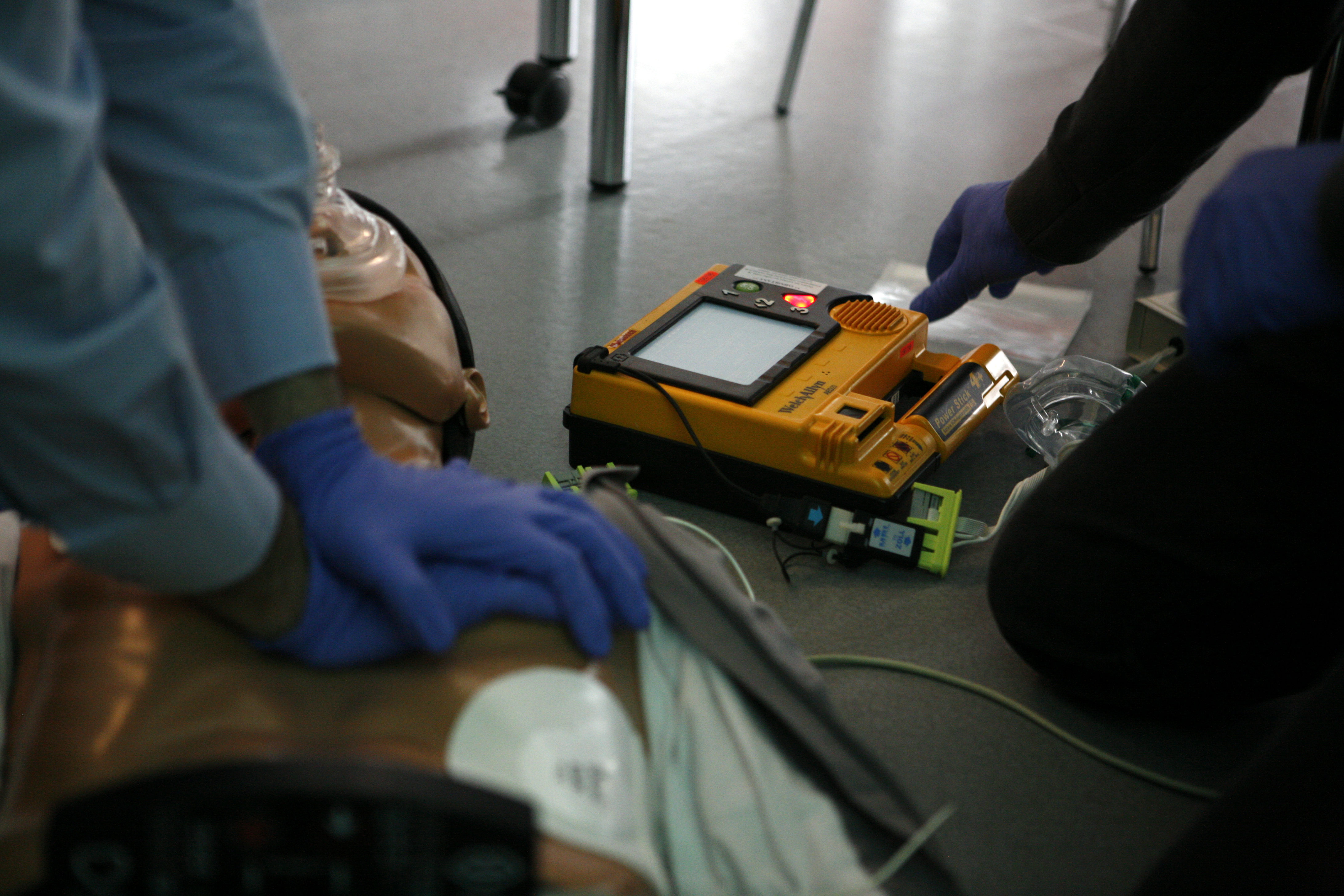|
Oropharyngeal Airway
An oropharyngeal airway (also known as an oral airway, OPA or Guedel pattern airway) is a medical device called an ''airway adjunct'' used in airway management to maintain or open a patient's airway. It does this by preventing the tongue from covering the epiglottis, which could prevent the person from breathing. When a person becomes unconscious, the muscles in their jaw relax and allow the tongue to obstruct the airway. History and usage The oropharyngeal airway was designed by Arthur Guedel. Oropharyngeal airways come in a variety of sizes, from infant to adult, and are used commonly in pre-hospital emergency care and for short term airway management post anaesthetic or when manual methods are inadequate to maintain an open airway. This piece of equipment is utilized by certified first responders, emergency medical technicians, paramedics, anesthesia providers, and other health professionals when tracheal intubation is either not available, not advisable or the problem ... [...More Info...] [...Related Items...] OR: [Wikipedia] [Google] [Baidu] |
Airway Management
Airway management includes a set of maneuvers and medical procedures performed to prevent and relieve an airway obstruction. This ensures an open pathway for gas exchange between a patient's lungs and the atmosphere. This is accomplished by either clearing a previously obstructed airway; or by preventing airway obstruction in cases such as anaphylaxis, the Obtundation, obtunded patient, or medical sedation. Airway obstruction can be caused by the tongue, foreign objects, the tissues of the airway itself, and bodily fluids such as blood and gastric contents (Pulmonary aspiration, aspiration). Airway management is commonly divided into two categories: Basic airway management, basic and Advanced airway management, advanced. Basic techniques are generally non-invasive and do not require specialized medical equipment or advanced training. Techniques might include head and neck maneuvers to optimize ventilation, abdominal thrusts, and back blows. Advanced techniques require specialized ... [...More Info...] [...Related Items...] OR: [Wikipedia] [Google] [Baidu] |
Tongue Depressor
A tongue depressor or spatula is a tool used in medical practice to depress the tongue to allow for examination of the mouth and throat. Hobbyists, artists, teachers and confectionery makers use tongue depressors, which may also be referred to as craft sticks or popsicle sticks. Description A tongue depressor is a tool used in medical practice to depress the tongue to allow for examination of the mouth and throat. For this use, it is also known as a spatula. History Earlier versions of depressors were made from balsa, pine, or redwood woods. Tongue depressors made from wood and metal exist from the American Civil War. The most common modern tongue depressors are flat, thin, wooden blades, smoothed and rounded at both ends, but, historically, tongue depressors have been made of a variety of materials. Since they are inexpensive and difficult to clean because of their porous texture, wooden tongue depressors are labeled for disposal after a single usage. Other uses ... [...More Info...] [...Related Items...] OR: [Wikipedia] [Google] [Baidu] |
Anesthesia
Anesthesia (American English) or anaesthesia (British English) is a state of controlled, temporary loss of sensation or awareness that is induced for medical or veterinary purposes. It may include some or all of analgesia (relief from or prevention of pain), paralysis (muscle relaxation), amnesia (loss of memory), and unconsciousness. An individual under the effects of anesthetic drugs is referred to as being anesthetized. Anesthesia enables the painless performance of procedures that would otherwise require physical restraint in a non-anesthetized individual, or would otherwise be technically unfeasible. Three broad categories of anesthesia exist: * ''General anesthesia'' suppresses central nervous system activity and results in unconsciousness and total lack of Sensation (psychology), sensation, using either injected or inhaled drugs. * ''Sedation'' suppresses the central nervous system to a lesser degree, inhibiting both anxiolysis, anxiety and creation of long-term memory, ... [...More Info...] [...Related Items...] OR: [Wikipedia] [Google] [Baidu] |
Guedel's Classification
Guedel's classification is a means of assessing the depth of general anesthesia introduced by Arthur Ernest Guedel (1883–1956) in 1920. History Since general anesthesia first became widely used in late 1846, assessment of anesthetic depth was a problem. To determine the depth of anesthesia, the anesthetist relies on a series of physical signs of the patient. In 1847, John Snow (1813–1858) and Francis Plomley attempted to describe various stages of general anesthesia, but Guedel in 1937 described a detailed system which was generally accepted. This classification was designed for use of a sole inhalational anesthetic agent, diethyl ether (commonly referred to as simply "ether"), in patients who were usually premedicated with morphine and atropine. At that time, intravenous anesthetic agents were not yet in common use, and neuromuscular-blocking drugs were not used at all during general anesthesia. The introduction of neuromuscular blocking agents (such as succinylcholine ... [...More Info...] [...Related Items...] OR: [Wikipedia] [Google] [Baidu] |
Bag Valve Mask
A bag valve mask (BVM), sometimes known by the proprietary name Ambu bag or generically as a manual resuscitator or "self-inflating bag", is a hand-held device commonly used to provide Modes of mechanical ventilation, positive pressure ventilation to patients who are not breathing or not breathing adequately. The device is a required part of resuscitation kits for trained professionals in out-of-hospital settings (such as ambulance crews) and is also frequently used in hospitals as part of standard equipment found on a crash cart, in emergency rooms or other critical care settings. Underscoring the frequency and prominence of BVM use in the United States, the American Heart Association (AHA) Guidelines for Cardiopulmonary Resuscitation and Emergency Cardiac Care recommend that "all healthcare providers should be familiar with the use of the bag-mask device." Manual resuscitators are also used within the hospital for temporary ventilation of patients dependent on mechanical ventilato ... [...More Info...] [...Related Items...] OR: [Wikipedia] [Google] [Baidu] |
Airway Management
Airway management includes a set of maneuvers and medical procedures performed to prevent and relieve an airway obstruction. This ensures an open pathway for gas exchange between a patient's lungs and the atmosphere. This is accomplished by either clearing a previously obstructed airway; or by preventing airway obstruction in cases such as anaphylaxis, the Obtundation, obtunded patient, or medical sedation. Airway obstruction can be caused by the tongue, foreign objects, the tissues of the airway itself, and bodily fluids such as blood and gastric contents (Pulmonary aspiration, aspiration). Airway management is commonly divided into two categories: Basic airway management, basic and Advanced airway management, advanced. Basic techniques are generally non-invasive and do not require specialized medical equipment or advanced training. Techniques might include head and neck maneuvers to optimize ventilation, abdominal thrusts, and back blows. Advanced techniques require specialized ... [...More Info...] [...Related Items...] OR: [Wikipedia] [Google] [Baidu] |
Edema
Edema (American English), also spelled oedema (British English), and also known as fluid retention, swelling, dropsy and hydropsy, is the build-up of fluid in the body's tissue (biology), tissue. Most commonly, the legs or arms are affected. Symptoms may include skin that feels tight, the area feeling heavy, and joint stiffness. Other symptoms depend on the underlying cause. Causes may include Chronic venous insufficiency, venous insufficiency, heart failure, kidney problems, hypoalbuminemia, low protein levels, liver problems, deep vein thrombosis, infections, kwashiorkor, angioedema, certain medications, and lymphedema. It may also occur in immobile patients (stroke, spinal cord injury, aging), or with temporary immobility such as prolonged sitting or standing, and during menstruation or pregnancy. The condition is more concerning if it starts suddenly, or pain or shortness of breath is present. Treatment depends on the underlying cause. If the underlying mechanism involve ... [...More Info...] [...Related Items...] OR: [Wikipedia] [Google] [Baidu] |
Iatrogenic
Iatrogenesis is the causation of a disease, a harmful complication, or other ill effect by any medical activity, including diagnosis, intervention, error, or negligence." Iatrogenic", ''Merriam-Webster.com'', Merriam-Webster, Inc., accessed 27 Jun 2020. First used in this sense in 1924, the term was introduced to sociology in 1976 by Ivan Illich, alleging that industrialized societies impair quality of life by overmedicalizing life."iatrogenesis" ''A Dictionary of Sociology'', . updated 31 May 2020. Iatrogenesis may thus include mental suffering via medical beliefs or a practitioner's statements. Some iatrogen ... [...More Info...] [...Related Items...] OR: [Wikipedia] [Google] [Baidu] |
Bronchospasm
Bronchospasm or a bronchial spasm is a sudden bronchoconstriction, constriction of the muscles in the walls of the bronchioles. It is caused by the release (degranulation) of substances from mast cells or basophils under the influence of anaphylatoxins. It causes difficulty in breathing which ranges from mild to severe. Bronchospasms occur in asthma, chronic bronchitis and anaphylaxis. Bronchospasms are a possible side effect of some drugs: pilocarpine, beta blockers (used to treat hypertension), a paradoxical result of using Long acting beta-adrenoceptor agonist, LABA drugs (to treat COPD), and other drugs. Bronchospasms can present as a sign of giardiasis. Some factors that contribute to bronchospasm include consuming certain foods, taking certain medicines, allergic responses to insects, and fluctuating hormone levels, particularly in women. Bronchospasms are one of several conditions associated with cold housing. The overactivity of the bronchioles' muscle is a result of ex ... [...More Info...] [...Related Items...] OR: [Wikipedia] [Google] [Baidu] |
Laryngospasm
Laryngospasm is an uncontrolled or involuntary muscular contraction ( spasm) of the vocal folds. It may be triggered when the vocal cords or the area of the trachea below the vocal folds detects the entry of water, mucus, blood, or other substance. It may be associated with stridor or retractions. Signs and symptoms Laryngospasm is characterized by involuntary spasms of the laryngeal muscles. It is associated with difficulty or inability to breathe or speak, retractions, a feeling of suffocation, which may be followed by hypoxia-induced loss of consciousness. It may be followed by paroxysmal coughing and in partial laryngospasms, a stridor may be heard. It requires prompt identification to avoid possibly fatal complications. It may present with loss of end-tidal carbon dioxide (for mechanically ventilated patients), chest or neck retractions and paradoxical chest wall movements. The condition typically lasts less than 60 seconds, but in cases of partial blocking it may la ... [...More Info...] [...Related Items...] OR: [Wikipedia] [Google] [Baidu] |
Emesis
Vomiting (also known as emesis, puking and throwing up) is the forceful expulsion of the contents of one's stomach through the mouth and sometimes the nose. Vomiting can be the result of ailments like food poisoning, gastroenteritis, pregnancy, motion sickness, or hangover; or it can be an after effect of diseases such as brain tumors, elevated intracranial pressure, or overexposure to ionizing radiation. The feeling that one is about to vomit is called nausea; it often precedes, but does not always lead to vomiting. Impairment due to alcohol or anesthesia can cause inhalation of vomit. In severe cases, where dehydration develops, intravenous fluid may be required. Antiemetics are sometimes necessary to suppress nausea and vomiting. Self-induced vomiting can be a component of an eating disorder such as bulimia nervosa, and is itself now classified as an eating disorder on its own, purging disorder. Complications Aspiration Vomiting is dangerous if gastric content enters the ... [...More Info...] [...Related Items...] OR: [Wikipedia] [Google] [Baidu] |
Cardiopulmonary Resuscitation
Cardiopulmonary resuscitation (CPR) is an emergency procedure used during Cardiac arrest, cardiac or Respiratory arrest, respiratory arrest that involves chest compressions, often combined with artificial ventilation, to preserve brain function and maintain circulation until spontaneous breathing and heartbeat can be restored. It is indication (medicine), recommended for those who are unresponsive with no breathing or abnormal breathing, for example, agonal respirations. CPR involves chest compressions for adults between and deep and at a rate of at least 100 to 120 per minute. The rescuer may also provide artificial ventilation by either exhaling air into the subject's mouth or nose (mouth-to-mouth resuscitation) or using a device that pushes air into the subject's lungs (mechanical ventilation). Current recommendations emphasize early and high-quality chest compressions over artificial ventilation; a simplified CPR method involving only chest compressions is recommended for ... [...More Info...] [...Related Items...] OR: [Wikipedia] [Google] [Baidu] |






